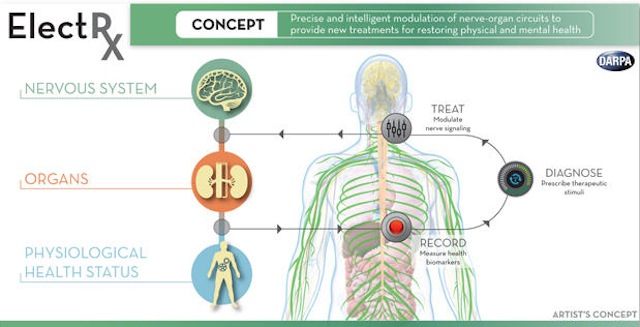As part of its ElectRx program, which seeks to heal by treating the body like the electrical system it is, the government agency has awarded grants to seven teams

© DARPA
Much like robots, humans depend on internal electricity to function. Our nervous systems pretty much consist of sparks of electricity jumping from one nerve to another to regulate nearly all our vital functions. Our brains are storms of electricity, our hearts pump thanks to electrical impulses and we make sense of the images that come in through our eyes through an electrical process.
It makes sense then that the Defense Advanced Research Projects Agency (DARPA), a unit within the US Department of Defense that focuses on cutting-edge research for military applications, is interested in exploring ways to treat the human body as the electrical system it really is.
DARPA has created an initiative called Electrical Prescriptions, or ElectRx, to investigate how light, sound waves, magnets and outside electrical pulses could help soldiers heal. On Monday, the agency announced that it will be awarding grants to seven different teams involved with mapping and treating the body's electrical systems.
"The peripheral nervous system [communicates] a vast array of sensory and motor signals that monitor our health status and effect changes in brain and organ functions to keep us healthy," ElectRx program manager Doug Weber explained in a statement. Weber is a biomedical engineer who previously worked as a researcher for the US Department of Veterans Affairs.
"
We envision technology that can detect the onset of disease and react automatically to restore health by stimulating peripheral nerves to modulate functions in the brain, spinal cord and internal organs."
Each of the teams chosen by DARPA will be investigating a different way of approaching health and healing.
According to
Spectrum, the magazine published by the Institute of Electrical and Electronics Engineers,
one team will be looking at using pulses of light to affect reactions involved in pain. Another will use magnetic nanoparticles to heat neurons and activate. Another team will examine the mechanics of how ultrasound stimulates neurons.
"Ultimately, the program envisions a complete system that can be tested in human clinical trials aimed at conditions such as chronic pain, inflammatory disease, post-traumatic stress and other illnesses that may not be responsive to traditional treatments," DARPA said.
To that end, some of the research will focus on understanding inflammation in the intestines and the body at large.
Another investigation will focus on how stimulating the vagus nerve could "enhance learned behavioral responses that reduce fear and anxiety when presented with traumatic cues" and help treat post-traumatic stress syndrome. The vagus nerve is the longest cranial nerve and helps control the parasympathetic nervous system, which is involved in regulating our heart rate and the activity in our intestines.
"Using the peripheral nervous system as a medium for delivering therapy is largely new territory and it's rich with potential to manage many of the conditions that impact the readiness of our military and, more generally, the health of the nation," Weber said. "It will be an exciting path forward."
Comment: Under the illusion of helping the troops in the mythical war on terror, there is an endless sea of tax dollars for these destructive murdering thugs to spend. What do you suppose they really want this technology for? We doubt it's for health and healing.